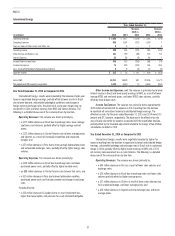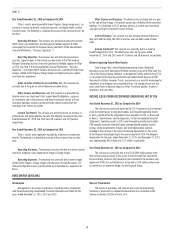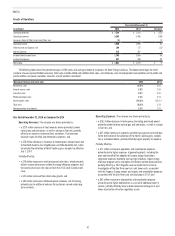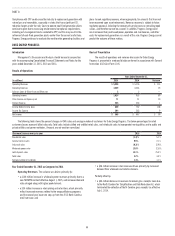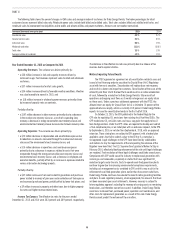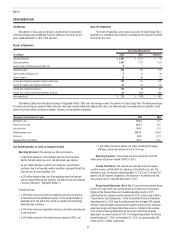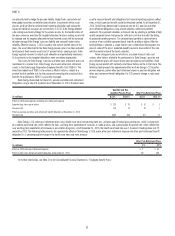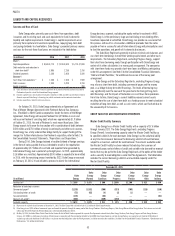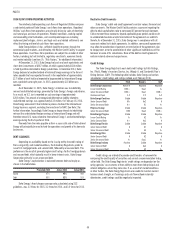Duke Energy 2015 Annual Report Download - page 65
Download and view the complete annual report
Please find page 65 of the 2015 Duke Energy annual report below. You can navigate through the pages in the report by either clicking on the pages listed below, or by using the keyword search tool below to find specific information within the annual report.
45
PART II
Operating Expenses. The variance was driven primarily by:
• a $61 million increase in depreciation and amortization expenses primarily
due to higher depreciation related to additional plant in service; and
• an $18 million reversal in 2014 of a prior-year impairment. These
charges related to planned transmission projects for which recovery
is not expected, and certain cost associated with mitigation sales
pursuant to merger settlement agreements with the FERC.
Partially offset by:
• a $34 million decrease in property and other taxes primarily due to the
termination of the collection of the North Carolina gross receipts tax as
mentioned above; and
• an $18 million decrease in operations and maintenance expenses,
primarily due to a 2014 litigation reserve related to the criminal
investigation of the management of North Carolina coal ash basins, lower
storm restoration costs and a favorable pension expense adjustment
recorded in 2015, partially offset by higher nuclear refueling outage
expenses, including the prior-year benefit of the adoption of nuclear
outage levelization, due to three refueling outages in 2015 compared to
one outage during the same period in 2014, higher nuclear costs related
to additional ownership interest in assets acquired from NCEMPA, and
severance expenses in 2015 related to cost savings initiatives.
Other Income and Expenses, net. The variance is due to higher AFUDC
equity, primarily due to nuclear plant expenditures.
Income Tax Expense. The effective tax rates for the years ended
December 31, 2015 and 2014 were 34.2 percent and 37.9 percent, respectively.
The decrease in the effective tax rate was primarily due to the non-deductible
litigation reserve related to the criminal investigation of the management of the
coal ash basins in 2014, an increase in AFUDC equity, and the reduction of the
North Carolina statutory corporate state income tax rate.
Matters Impacting Future Results
Duke Energy Progress is a party to multiple lawsuits and subject to
fines and other penalties related to operations at certain North Carolina
facilities with ash basins. The outcome of these lawsuits, fines and penalties
could have an adverse impact on Duke Energy Progress’ financial position,
results of operations and cash flows. See Note 5 to the Consolidated Financial
Statements, “Commitments and Contingencies,” for additional information.
An order from regulatory authorities disallowing recovery of costs related
to closure of ash impoundments could have an adverse impact on Duke Energy
Progress’ financial position, results of operations and cash flows. See Notes 4
and 9 to the Consolidated Financial Statements, “Regulatory Matters” and
“Asset Retirement Obligations,” respectively, for additional information.
On October 23, 2015, the EPA published in the Federal Register the
CPP rule for regulating CO2 emissions from existing fossil fuel-fired EGUs. The
CPP establishes CO2 emission rates and mass cap goals that apply to fossil
fuel-fired generation. Under the CPP, states are required to develop and submit
a final compliance plan, or an initial plan with an extension request, to the EPA
by September 6, 2016, or no later than September 6, 2018, with an approved
extension. These state plans are subject to EPA approval, with a federal plan
applied to states that fail to submit a plan to the EPA or if a state plan is
not approved. Legal challenges to the CPP have been filed by stakeholders
and motions to stay the requirements of the rule pending the outcome of the
litigation have been filed. The U.S. Supreme Court granted a Motion to Stay in
February 2016, effectively blocking enforcement of the rule until legal challenges
are resolved. Final resolution of these legal challenges could take several years.
Compliance with CPP could cause the industry to replace coal generation with
natural gas and renewables, especially in states that have significant CO2
reduction targets under the rule. Costs to operate coal-fired generation plants
continue to grow due to increasing environmental compliance requirements,
including ash management costs unrelated to CPP, and this may result in
the retirement of coal-fired generation plants earlier than the current useful
lives. Duke Energy Progress continues to evaluate the need to retire generating
facilities and plans to seek regulatory recovery, where appropriate, for amounts
that have not been recovered upon asset retirements. However, recovery is
subject to future regulatory approval, including the recovery of carrying costs
on remaining book values, and therefore cannot be assured. In addition, Duke
Energy Progress could incur increased fuel, purchased power, operation and
maintenance, and other costs for replacement generation as a result of this rule.
Duke Energy Progress cannot predict the outcome of these matters.
DUKE ENERGY FLORIDA
Introduction
Management’s Discussion and Analysis should be read in conjunction
with the accompanying Consolidated Financial Statements and Notes for the
years ended December 31, 2015, 2014 and 2013.
Basis of Presentation
The results of operations and variance discussion for Duke Energy
Florida is presented in a reduced disclosure format in accordance with General
Instruction (I)(2)(a) of Form 10-K.
Results of Operations
Years Ended December 31,
(in millions) 2015 2014 Variance
Operating Revenues $ 4,977 $ 4,975 $ 2
Operating Expenses 3,862 3,898 (36)
Gains on Sales of Other Asset and Other, net —1 (1)
Operating Income 1,115 1,078 37
Other Income and Expense, net 24 20 4
Interest Expense 198 201 (3)
Income Before Income Taxes 941 897 44
Income Tax Expense 342 349 (7)
Net Income $ 599 $ 548 $ 51




